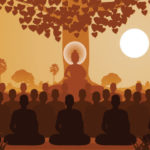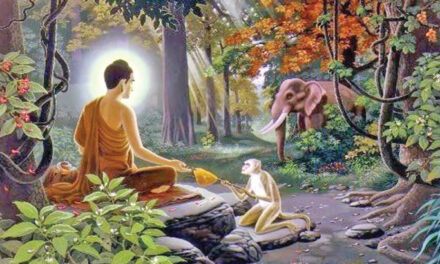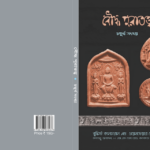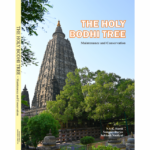
About Dhamma
THE DHAMMA (TEACHING OF THE BUDDHA)
The Buddha then set out for Varanasi where at the Deer Park (Mrigadayavana) in Isipatana, modern Sarnath where the first sermon (the Dhammachakka pavattana) was expounded or the setting in motion the Wheel of the Law to the first five disciples who earlier were in the initial years closely associated with Siddhartha for six long years, exhorting them to avoid the two extremes of self-indulgence and self mortification. Self-indulgence leads to retardation of spiritual progress and the latter weakens one’s intelligence. The Buddha expounded the Dhamma based on the Four Noble Truths i.e., Dukkha (Suffering) , the cause of Dukkha (Suffering), the cessation of Dukkha (Suffering) and the path leading to the cessation of Dukkha which was through Ārya Atthangika Magga (the Noble Eightfold Path) consisting of Right Speech, Right Action, Right Livelihood, Right Effort, Right Mindfulness, Right Concentration, Right Understanding and Right Thought. The Dhamma which is based on the three pillars of Sila (Morality), Samādhi (Concentration) and Prajñā (Wisdom) which in other words is also called the Middle Way or the righteous way of life. The Buddha established the Sangha or the Order of Monks for the creation of an ideal society based on Mettā (loving-kindness), Karunā (compassion), Muditā (sympathetic joy) and Upekkhā (equanimity) which was free from class, caste and colour prejudices and maintained equality, freedom, justice, fraternity and brotherhood.
Love, mercy, patience, self-denial, alms-giving, truth, and the cultivation of wisdom, he required of all. Good actions, good words, and good thoughts were the frequent subjects of his sermons; and he was unceasing in his cautions to keep the mind free from the turmoil of passion, and the cares of life.
Buddhism which embraced those doctrines, together with the systems of worship that have grown out of it, has numbered more adherents and influenced more men, than any other system of belief historically known-perhaps than all others together.
Buddhism, however, according to a true definition of the word religion, or any purely technical use of the term, is not a religion. It does truly admit, in a modified way, nearly the whole pantheon of early Hinduism and all the demons, ghosts, spirits and fairies that belong to the wild superstitions of the peoples; but yet it nowhere admits any real god on any superhuman being worthy of worship; it has no temples; it admits neither altars nor sacrifices; it has no true priests; it knows no prayers, no ritual, no religious rites of any kind.
Buddhism is simply an atheistic system of Philosophy and Ethics-a Philosophy of humanity in its environment, so clear, so profound, so positive, that it is destined not only to astonish, but to largely modify, at no distant day, the thought of the West. Ethics which have already begun to awaken surprise and admiration in many who had not believed that any good thing could come out of heathenism.
In a broader, more popular use of the word, however, Buddhism is a religion : and is rightly studied as such in connection with other great religions that have influenced large masses of men.
A religion is always a growth. No religion ever started as an absolutely new and completely perfected system; but each, with constant changes, developed out of something, or in connection with something, that went before. Curiously enough, this word growth in this connection partakes of both senses in which it is used, respectively, of organic development and of inorganic increase; for in religion, there is always something that, like the principle of life, itself-developing from within, according to regular organic law, while, at the same time, there are whole masses of outer accretions like the glittering stalactites and stalagmites of a calcareous cavern, or the slimy alluvial flats of a great river delta.
The Buddha in course of 45 years of his ministry moved from village to village, town to town, city to city alongwith His retinue of monks following His own prescribed dictum ‘Bahujana Hitāya, Bahujana Sukhāya’ and finally at the age of 80 he attained Mahāparinibbāna (left His body in meditation) lying between two Sal trees. It is an event of unique significance that all the three events of the Buddha, His Birth, Enlightenment and Mahāparinibbāna all took place in the forest and beneath the trees and all happened at a single day on the full Moon Day of Vaisākha in the Sal grove at Kusinara, modern Kushinagar.







![Monuments of Mahabodhi [Mahavihara] Temple Complex Bodhgaya](https://baruasamaj.ezdivi.com/wp-content/uploads/sites/5/2023/10/Monuments-Book-Title-150x150.png)


